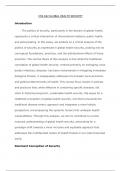CSS AS2 GLOBAL HEALTH SECURITY
Introduction
The politics of security, particularly in the domain of global health,
represents a critical intersection of international relations, public health,
and policymaking. In this essay, we embark on a critical analysis of the
politics of security as expressed in global health security, probing into its
conceptual foundations, practices, and the distributional effects of these
practices. The central thesis of this analysis is that while the traditional
conception of global health security- centred primarily on managing cross-
border infectious diseases- has been instrumental in mitigating immediate
biological threats, it inadequately addresses the broader socio-economic
and political determinants of health. This narrow focus results in policies
and practices that, while effective in containing specific diseases, fall
short in fostering long-term, sustainable health security. We argue for a
redefined conception of global health security, one that transcends the
traditional disease-centric approach and integrates a more holistic
perspective, encompassing the systemic factors that underpin health
vulnerabilities. Through this analysis, we aim to contribute to a more
nuanced understanding of global health security, advocating for a
paradigm shift towards a more inclusive and equitable approach that
addresses the multifaceted nature of health threats in our interconnected
world.
Dominant Conception of Security
, In the realm of global health security, the dominant conception of
security has traditionally been centred around the prevention and control
of infectious disease outbreaks that pose a significant risk to international
health and stability. This perspective primarily views security through the
lens of safeguarding populations from biological threats, including
emerging infectious diseases and bioterrorism. According to McInnes and
Lee (2006), this approach has largely been influenced by the
securitization theory, which posits that certain issues are framed as
existential threats requiring emergency measures and often legitimising
extraordinary means to address them. The framing of health as a security
issue gained particular prominence in the aftermath of the 2003 SARS
outbreak and the 2014 Ebola crisis, as these events highlighted the
transnational nature of health risks and their potential to disrupt global
order (Davies, 2008; Elbe, 2010). However, this conception has been
critiqued for its narrow focus on specific types of threats, often
overlooking broader determinants of health such as healthcare access and
socio-economic conditions (Rushton, 2011).
The conception of what needs to be secured in the context of global
health security extends beyond the mere containment of diseases to
encompass the protection of complex health systems and populations at
large. This broader view recognizes that threats to health security are not
only biological agents but also include the systemic weaknesses in
healthcare infrastructure and disparities in health access. As argued by
McInnes and Rushton (2010), global health security involves safeguarding
both the physical well-being of populations and the systems that support
, health, including medical supply chains, healthcare facilities, and public
health institutions. This inclusive perspective is underscored by the 2005
International Health Regulations (IHR), which expanded the definition of
health emergencies of international concern, highlighting the necessity to
protect against not just specific diseases but also against threats posed by
weak health systems and inadequate response capacities (Fidler, 2005;
Kamradt-Scott, 2015). Such an understanding of security reflects a shift
towards a more holistic approach, recognizing that vulnerabilities in one
part of the global health system can have cascading effects, undermining
health security on a global scale (Bozorgmehr et al., 2010).
Who or What is to be Secured
In the discourse of global health security, the entities that are
primarily considered to be at risk and thus in need of being secured are
both individual populations and the international community at large. This
dual focus encompasses protecting specific groups, such as those in
regions with weak healthcare infrastructure or in areas prone to
outbreaks, and the global population as a whole from the spread of
infectious diseases. As highlighted by Davies (2010), the emphasis is
often on vulnerable populations in developing countries, which are seen
as epicentres for the emergence of infectious diseases due to factors like
poverty, political instability, and inadequate health systems. However, the
interconnectedness of global health means that threats are not confined
to these areas; as Buse and Harmer (2004) point out, diseases can rapidly
traverse borders, making global health security a universally relevant
issue. This perspective was starkly illustrated by the H1N1 pandemic of




